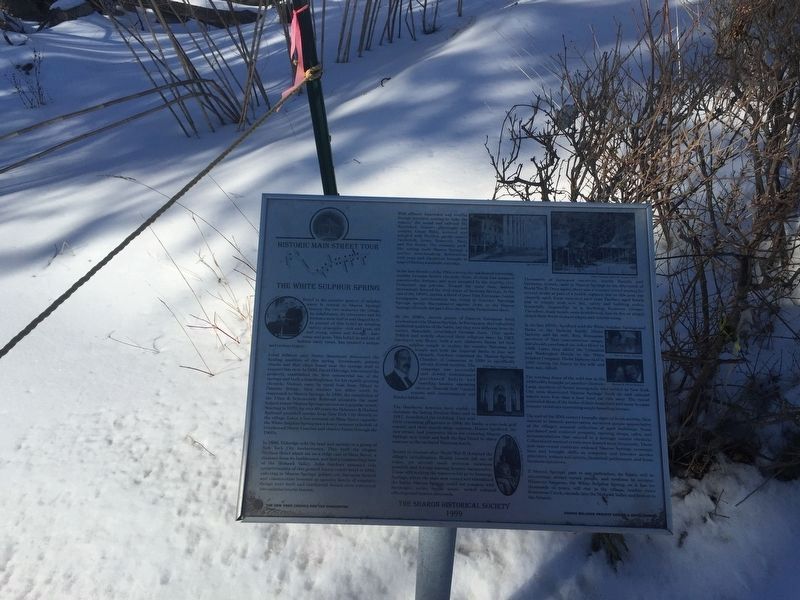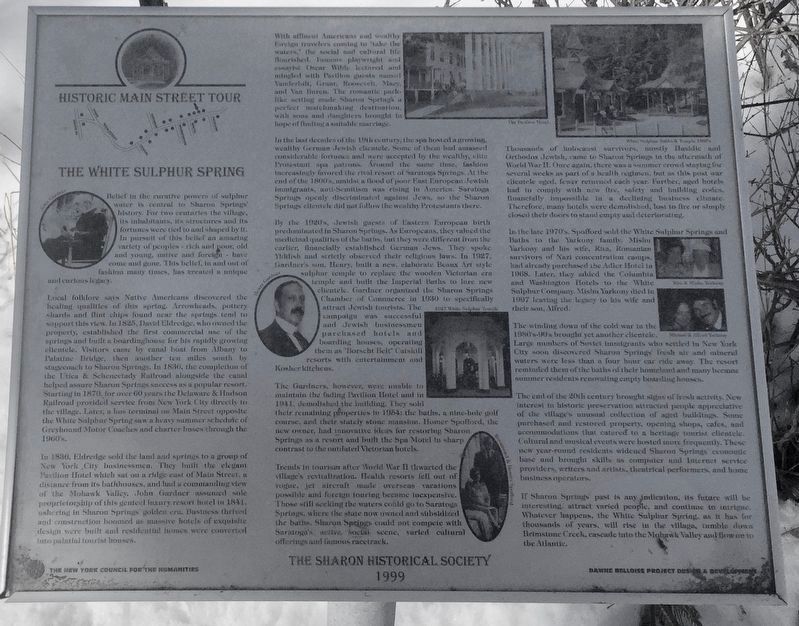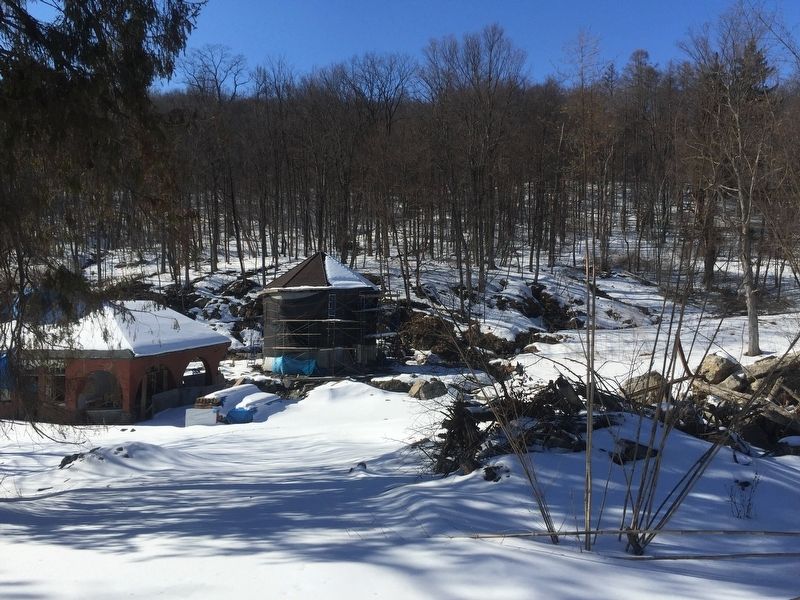Sharon Springs in Schoharie County, New York — The American Northeast (Mid-Atlantic)
The White Sulphur Spring
Historic Main Street Tour
Local folklore says Native Americans discovered the healing qualities of this spring. Arrowheads, pottery shards and flint chips found near the spring tend to support this view. In 1825, David Eldridge, who owned the property, established the first commercial use of the springs, and built a boardinghouse for his rapidly growing clientele. Visitors came by canal boat from Albany to Palatine Bridge, then another ten miles south by stagecoach to Sharon Springs. In 1830, the completion of the Utica & Schenectady Railroad alongside the canal helped assure Sharon Springs success as a popular resort. Starting in 1870, for over 60 years, the Delaware & Hudson Railroad provided service from New York City directly to the village. Later, a bus terminal on Main Street opposite the White Sulphur Spring saw a heavy summer schedule of Greyhound Motor Coaches and charter buses through the 1960’s.
In 1830, Eldridge sold the land and springs to a group of New York City businessmen. They built the elegant Pavilion Hotel which sat on a ridge east of Main Street, a distance from its bathhouses, and had a commanding view of the Mohawk Valley. John Gardner assumed the sole proprietorship of this genteel luxury resort in 1841, ushering in Sharon Springs’ golden era. Business thrived and construction boomed as massive hotels of exquisite design were built and residential homes were converted into palatial tourist houses.
With affluent Americans and wealthy foreign travelers coming to “take the waters,” the social and cultural life flourished. Famous playwrights and essayist Oscar Wilde lectured and mingled with Pavilion guests named Vanderbilt, Grant, Roosevelt, Macy, and Van Buren. The romantic park-like setting made Sharon Springs a perfect matchmaking destination, with sons and daughters brought in hope of finding a suitable marriage.
In the last decade of the 19th century, the spa hosted a growing wealthy German Jewish clientele. Some of them had amassed considerable fortunes and were accepted by the wealthy, elite Protestant spa patrons. Around the same time, fashion increasingly favored the rival resort of Saratoga Springs. At the end of the 1800’s, amidst a flood of poor East European Jewish immigrants, anti-Semitism was rising in America. Saratoga Springs openly discriminated against Jews, so the Sharon Springs clientele did not follow the wealthy Protestants there.
By the 1920’s Jewish guests of Eastern European birth predominated in Sharon Springs. As Europeans, they valued the medicinal qualities of the baths, but they were different from the earlier, financially established German Jews. They spoke Yiddish and strictly observed their religious laws. In 1927, Gardner’s son Henry, built a new, elaborate Beaux Art style sulphur temple to replace the wooden Victorian era temple and built the Imperial Baths to lure new Clientele. Gardner organized the Sharon Springs Chamber of Commerce in 1930 to specifically attract Jewish tourists. The campaign was successful and Jewish businessmen purchased hotels and boarding houses, operating them as “Borscht “Belt” Catskill resorts with entertainment and Kosher kitchens.
The Gardners, however, were unable to maintain the fading Pavilion Hotel, and in 1941, demolished the building. They sold their remaining properties in 1954: the baths, a nine-hole golf course, and their stately stone mansion. Homer Spofford, the new owner, had innovative ideas for restoring Sharon Springs as a resort and built the Spa Motel in sharp contrast to the outdated Victorian hotels.
Trends in tourism after World War II thwarted the village’s revitalization. Health resorts fell out of vogue, jet aircraft made oversea vacations possible and foreign touring inexpensive. Those still seeking the waters could go to Saratoga Springs where the state now owned and subsidized the baths. Sharon Springs could not compete with Saratoga’s active social scene, varied cultural offerings, and famous racetrack.
Thousands of holocaust survivors, mostly Hasidic and Orthodox Jewish, came to Sharon Springs in the aftermath of World War II. Once again there was a summer crowd staying for several weeks as part of a health regimen, but as this post war clientele aged, fewer returned each year. Further, aged hotels had to comply with new fire, safety, and building codes, financially impossible in a declining business climate. Therefore, many hotels were demolished, lost to fire or simply closed their doors to stand empty and deteriorating.
In the late 1970’s, Spofford sold the White Sulphur Springs and Baths to the Yarkony family Mishu Yarkony and his wife Rita, Romanian survivors of Nazi concentration camps had already purchased the Adler Hotel in 1968. Later, they added the Columbia and Washington Hotels to the White Sulphur Company. Mishu Yarkony died in 1997, leaving this legacy to his wife and their son Alfred.
The winding down of the cold war in the 1980’s-90’s brought yet another clientele. Large numbers of Soviet immigrants who settled in New York City soon discovered Sharon Springs’ fresh air and mineral waters were less than a four hour car ride away. The resort reminded them of the baths of their homeland and many became summer residents renovating empty boarding houses.
The end of the 20th century brought signs of fresh activity. New interest in historic preservation attracted people appreciative of the village’s unusual collection of aged buildings. Some purchased and restored property, opening shops, cafes and accommodations that catered to a heritage clientele. Cultural and musical events were hosted more frequently. These new year-round residents widened Sharon Springs’ economic base and brought skills as computer and Internet service providers, writers and artists, theatrical performers, and home business operators.
If Sharon Springs' past is any indication, its future will be interesting, attract varied people, and continue to intrigue. Whatever happens, the White Sulphur Spring, as it has for thousands of years will rise in the village, tumble down Brimstone Creek, cascade into the Mohawk Valley and flow into the Atlantic.
Erected 1999 by Sharon Historical Society.
Topics. This historical marker is listed in these topic lists: Science & Medicine • Settlements & Settlers.
Location. 42° 47.835′ N, 74° 36.996′ W. Marker is in Sharon Springs, New York, in Schoharie County. Marker is on Main Street (New York State Route 10), on the left when traveling north. Touch for map. Marker is in this post office area: Sharon Springs NY 13459, United States of America. Touch for directions.
Other nearby markers. At least 8 other markers are within walking distance of this marker. Chestnut Street Schoolhouse (within shouting distance of this marker); The Magnesia Temple and Baths (within shouting distance of this marker); Historic Main Street Tour (about 300 feet away, measured in a direct line); a different marker also named Historic Main Street Tour (about 400 feet away); a different marker also named Historic Main Street Tour (approx. 0.2 miles away); a different marker also named Historic Main Street Tour (approx. 0.2 miles away); The American Hotel (approx. ¼ mile away); a different marker also named Historic Main Street Tour (approx. 0.3 miles away). Touch for a list and map of all markers in Sharon Springs.
Also see . . .
1. Sharon Springs hopes to escape fate as Saratoga Backwater (NY Times). (Submitted on March 11, 2019, by Steve Stoessel of Niskayuna, New York.)
2. Adler Hotel. (Submitted on March 11, 2019, by Steve Stoessel of Niskayuna, New York.)
Credits. This page was last revised on March 12, 2019. It was originally submitted on March 10, 2019, by Steve Stoessel of Niskayuna, New York. This page has been viewed 572 times since then and 132 times this year. Photos: 1. submitted on March 10, 2019, by Steve Stoessel of Niskayuna, New York. 2, 3. submitted on March 11, 2019, by Steve Stoessel of Niskayuna, New York. • Bill Pfingsten was the editor who published this page.


